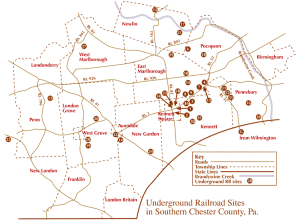Kennett Historical Commission details township, county role in leading slaves to freedom
By Jacqueline Kennedy, Correspondent, The Times

A map of some of the sites where Chester County residents housed newly-free slaves before and during the Civil War.
KENNETT — The Kennett Township Historical Commission held its annual meeting earlier this month that featured a presentation titled “Follow the Drinking Gourd” detailing the township and Chester County’s important role in the freedom of slaves as a hub of the Underground Railroad.
The meeting hosted two special guest speakers: Karen Marshall, Chester County Historical Preservation Officer who discussed The Harriet Tubman Freedom Trail and Chris Densmore, Curator of the Friends Historical Library in Swarthmore College, who presented a detailed history of the Underground Railroad in a Kennett Township.
The Underground Railroad was established in the early 1800’s and included many secret passageways beginning in the South that lead slaves across the Mason-Dixon Line to safety in the North. Slaves were seeking to escape bondage from what were known as slave states – found south of this line, in which ska very was considered legal by the United States Constitution.
In 1853, Harriet Tubman, one of the most popular anti-slavery activists and also once a slave herself began her moral deeds with the Underground Railroad. Once Harriet Tubman reached her freedom, she went back and freed her family and as many as three hundred others.
It is estimated that the Underground Railroad helped 100,000 slaves, escape from the South between 1810 and 1850 thanks to Harriet And many Northerners were determined to free as many slaves as possible. This group collectively became referred to as abolitionists.
Among those Northerners were the Quakers who were one of the very first groups to aid slaves in their escape. The abolitionists sometimes used their own homes to hide the runaways. These Northern citizens, including residents in Kennett area and throughout southern Chester County, took the law in their own hands. It was a very dangerous proposition for both slaves and abolitionists. If caught in the North, they would get fined for hundreds of dollars which was a lot of money back then because they broke the law. Some of the slaves were then captured and taken back to return to work. The slaves were property. If a Northerner was caught helping to free a slave in the South, the punishment was more severe. The citizen would be taken to court and then imprisoned, if he or she made it to court. The citizen would be beaten or burned by the slave owner for stealing his property. There are plenty of rumors on how these safe houses were identified. Some historians believe the information by word of mouth is exaggerated but still holds some truth.
The significance of the Drinking Gourd is the slaves who ran from the south would follow the Big Dipper to reach the North to safety. Once a slave reached a safe house, a network of supporters would donate clothes and money for food. The slaves were secretly passed from one family to another. They were hidden in barns, attics and basements.
The Kennett Historical Commission helps to preserve the history in the community and helps protect the buildings that were once inhabited by slaves. Chester County and the surrounding area have an enduring history with small brick homes in Chadds Ford and New Garden Memorial Church in Kennett Square, a direct descendant of a church started in 1820. These buildings were once used to keep slaves sheltered. Even Andrew Wyeth has paintings of the African American slaves.
In 1821, London Grove Meeting House formed an anti-kidnapping society to prevent legitimately free people from being stolen. Slave traders would travel north to kidnap legal citizens and escort them south to work as slaves. It was a lucrative business. Back then, in the 1800’s, the term “kidnapping” was used when slave traders would steal free people and sell them into slavery.
Historic Kennett Square stands up to its title with Historians identifying twenty-six known sites within a 15 mile radius that played key roles. Many consider this area to be very special because researchers believe that there may be hundreds of additional passageways and secrets yet to be discovered. However, because of the cost and time associated with thus research, it may take some time before the full history of Kennett Square’s role in the Underground Railroad is revealed.






